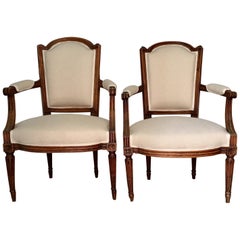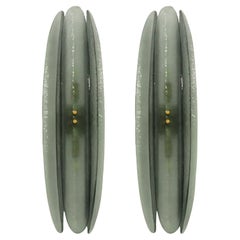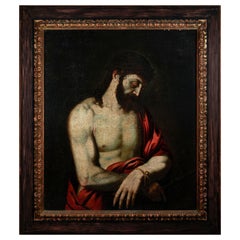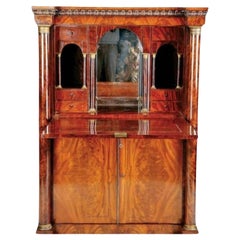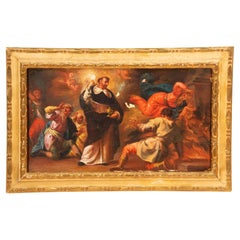Madrid
to
546
1,009,429
700,833
1,955
1,891
1,028
974
900
751
485
468
292
284
281
257
215
142
122
89
76
73
67
65
62
62
58
56
49
49
40
37
36
33
20
17
17
16
16
14
12
11
10
10
9
8
7
6
5
5
4
3
3
2
2
2
2
1
1
1
1
1
133
122
72
68
50
18th Century Pair of French Louis XVI Fauteuils or Armchairs
Located in Madrid, ES
Pair of armchairs or fauteuils, Luis XVI, late 18th century, in walnut wood with back sculpted in guilloche, on fluted tapering legs, the interior has been reinforced and restored, u...
Category
Late 18th Century French Louis XVI Antique Madrid
Materials
Walnut
$2,147 Sale Price / set
28% Off
Mid Century Style Murano Glass Sconces, Contemporary Design, Italy Murano
Located in Madrid, ES
Pair of Italian-designed wall lamps made of Scova Murano glass, featuring two light points and a brass structure. They have an oval design composed of three concave pieces.
Every ...
Category
21st Century and Contemporary Italian Modern Madrid
Materials
Brass
Amazing Tiziano Vecellio's Circle of the 17th century "Ecce Homo"
By Europa
Located in Madrid, ES
Amazing Tiziano Vecellio's Circle of the 17th century "Ecce Homo"
Oil on canvas, 17th century,
based on the original housed in the Kunsthistorisches Museum, Vienna.
Dimensions: 1...
Category
17th Century Italian Baroque Antique Madrid
Materials
Paint
Secretaire "a Abbatant" Napoleon III Empire, 19th Century
By Empire Furniture
Located in Madrid, ES
Title: Secretaire "a Abbatant"
Date/Period: 19th century
Dimension: 147cm x 105cm x 51cm.
Material: Mahogany wood
Additional Information: Secretaire "a Abbatant" French, Empire Style...
Category
Early 19th Century French Empire Antique Madrid
Materials
Wood
19th Century PORTUGUESE SAFE with Keys
Located in Madrid, ES
19th Century PORTUGUESE SAFE with Keys
in iron and wood.
Painted decoration with a door and drawer.
With key.
Dim.: 129 x 59.5 x 52.5 cm.
Category
Late 19th Century Portuguese Colonial Revival Antique Madrid
Materials
Iron
Saint Dominic. Oil on canvas. Spanish school, 18th century.
Located in Madrid, ES
Saint Dominic. Oil on canvas. Spanish school, 18th century.
It has some faults.
Oil on canvas with a horizontal layout depicting a Dominican wearing the characteristic habit of the ...
Category
18th Century Spanish Neoclassical Antique Madrid
Materials
Other
20th Century Art Deco Sweden Commode or Chest of Drawers
Located in Madrid, ES
An Art Deco chest of drawers in birch wood, marquetry, with three drawers and handles in copper and brass, the birch wood has been painted with floral motifs and lacquered, the key i...
Category
Mid-20th Century Swedish Art Deco Madrid
Materials
Birch
$1,868 Sale Price
20% Off
Mid-Century Modern Style Murano Glass and Brass Pair of Italian Table Lamps
Located in Ibiza, Spain
Pair of table lamps designed by L.A. Studio. Features a solid brass structure adorned with Murano colored glass pieces. Manufactured in Italy, they are complemented by circular lamps...
Category
21st Century and Contemporary Italian Mid-Century Modern Madrid
Materials
Brass
BRONZE HEAD of ROMAN EMPEROR CARACALLA
Located in Madrid, ES
A decorative bronze head of Roman Emperor Caracalla, mounted on a solid marble base. This striking piece captures the strength and presence of one of Rome's most famous emperors, com...
Category
Mid-20th Century Madrid
Materials
Bronze
0.75ct Natural Diamond Engagement Ring 18K White Gold – IGI Certified gift
Located in Sant Josep de sa Talaia, IB
Experience timeless elegance with this luxurious 18K white gold solitaire engagement ring, meticulously crafted to the highest standards of fine jewelry. Featuring a breathtaking 0.7...
Category
21st Century and Contemporary European Contemporary Madrid
Materials
Diamond, 18k Gold, White Gold
Carriage clock with case. 19th century
Located in Madrid, ES
Travel clock with case. Metal, glass, leather, etc. XIX century.
Case with lid at the top and front with a transparent glass sheet, upholstered on the inside, containing a travel cl...
Category
19th Century European Neoclassical Revival Antique Madrid
Materials
Metal, Other
Martin Logan Ascent Speakers Pair
By Logan
Located in Madrid, ES
Martin Logan Ascent Speakers Pair
Year of manufacture: 2005/2006
good condition, very lightly used
Frequently Asked Questions
35–22,000 Hz ± 3 dB
Recommended amplifier power
20–400 ...
Category
21st Century and Contemporary American Modern Madrid
Materials
Wood
$3,354 / set
Beautiful Italian Ceramics Plate from the 19th Century " Mythological Scene "
Located in Madrid, ES
Beautiful Italian Ceramics Plate from the 19th Century
Plate with large fire decoration in the center of a mythological scene and on the side a frieze of interlacing, mask, grotesque...
Category
19th Century Italian Baroque Antique Madrid
Materials
Ceramic
Chandelier or ceiling lamp, Louis XVI style. Bronze, glass. France, 19th century
Located in Madrid, ES
Chandelier or ceiling lamp, Louis XVI style. Bronze, glass. France, 19th century.
Ceiling lamp made of gilded bronze with transparent glass elements that has sixteen lights in total...
Category
19th Century European Rococo Revival Antique Madrid
Materials
Bronze, Other
Pair of leather-upholstered armchairs with teak wood frames
By Arne Vodder
Located in Madrid, España
Pair of leather-upholstered armchairs with teak wood frames - Arne Vodder - for Cado - Denmark - c. 1970
Category
1970s Danish Mid-Century Modern Vintage Madrid
Materials
Leather, Wood
Mahogany Neoclassical Bed Frame, 19th Century
Located in Madrid, ES
"Boat" bed in carved mahogany wood, 19th century.
Head and feet of the same height, are decorated with a circular molding, while the rear, by harmony, follows the lines of the front...
Category
19th Century European Neoclassical Antique Madrid
Materials
Wood, Mahogany
Sterling Silver Medallion reliquary – 18th Century
Located in Madrid, ES
Elegant 18th-century reliquary in solid silver, finely hand-engraved, with ornamental decoration typical of Baroque religious art. Its oval shape features floral and symbolic details...
Category
18th Century European Baroque Antique Madrid
Materials
Sterling Silver
Silver Pax O Portapaz, Spain, 16th Century
Located in Madrid, ES
Portapaz. Silver in its color and gilded. Century XVI.
Portapaz made of silver that has a handle (decorated with delicate plant motifs similar to those of the pilasters) and a female and a male bust at the bottom, as well as other architectural elements on the back, and, on the front, an architectural composition classicist basement (with busts flanking a flower and a cross), two pilasters (vegetal decoration and capital recalling the composite order) with entablature (flowers flanking an angel's head; moldings), and a semicircular arch finish with elements veined in relief under cross and flanked by two architectural motifs in the upper part. This composition frames and enhances a gilt silver relief where you can see the Lament or Cry over the Body of Christ, with the Virgin holding the head of Jesus, Saint John at her side, the Magdalene and other characters, a cross following the group and a landscape background with houses and plant elements. This architectural structure mentioned is similar to the one present in other 16th century portapaces, such as that of the Magdalena de Dos Hermanas parish (Hernando de Ballesteros el Mozo, around 1575); or that of the Galaroza parish (same author and date); or that of the portapaz of San Miguel de Jerez de los Caballeros (in some details); etc. As for the relief, it is possible to clearly see a strong Italian influence, and the similarity between it and important pieces such as the Portapaz known as “de Cisneros by Juan de Burgos (1493-1497; MuseoCatedralicio de Alcalá de Henares), as well as in paintings and reliefs. Also noteworthy are both the male and female busts in the lower area and the Maltese cross (or Saint John's) that appears in this area. This symbol was used since the 12th century as an insignia by the Knights Hospitallers of the Order of Saint John of Jerusalem, also known as the Order of Malta...
Category
16th Century Spanish Renaissance Antique Madrid
Materials
Silver
Napoleon III Bedroom Set, France, circa Second Half of the 19th Century
Located in Madrid, ES
Erable wood, pinewood interiors, tinted moldings.
Bedroom consists of a door closet with mirror, dresser desk with three drawers in the front and another three behind a door, in add...
Category
Mid-19th Century French Napoleon III Antique Madrid
Materials
Metal
Early 19th Century Giltwood Barometer "Selon Toricelli"
Located in Madrid, ES
Barometer end of the 18th century, Directorie, in carved and gilded wood, by Selon Toriceli, with allegory music wing on the top, beautiful patina, and decorative barometer...
Category
19th Century French Directoire Antique Madrid
Materials
Wood
$1,791 Sale Price
48% Off
Wooden Carousel Horse / Zebra, European Hand-Carved Folk Art Sculpture
Located in Madrid, ES
Detailed and expressive, this authentic handmade carousel / merry-go-round zebra demonstrates how popular or folk style sculpture can reach the level of high art. With its original p...
Category
Mid-20th Century French Folk Art Madrid
Materials
Iron
Tulip Dining Table Edited by Knoll Designed By Eero Saarinen
By Eero Saarinen
Located in Ibiza, Spain
The Tulip table, designed by Eero Saarinen in 1958, is an iconic piece that continues to set trends in interior design. It consists of a white-painted metal base and a round white ma...
Category
Mid-20th Century Central American Mid-Century Modern Madrid
Materials
Marble, Aluminum
Relief, “Ballerinas”. Modeled alabaster. 20th century, after CANOVA
Located in Madrid, ES
Relief, “Ballerinas”. Modeled alabaster. 20th century, following the CANOVA model, Antonio
Relief made of modeled alabaster with polychrome, enhanced with a somewhat modern frame th...
Category
20th Century Spanish Neoclassical Revival Madrid
Materials
Other
Porcelain Sculpture by Javier Calleja and Lladró, Limited Edition
By Javier Calleja
Located in Madrid, ES
Javier Calleja collaborates for the second time with the Spanish company Lladró.
As a result of this collaboration, they have created this sculptural piece featuring three figures fr...
Category
21st Century and Contemporary Spanish Madrid
Materials
Pottery, Porcelain, Glass
18th Century Portuguese "Azulejos" Panel "River Scene"
Located in Madrid, ES
Largest collection of Portuguese tiles in the world
18th century Portuguese " Azulejos " River Scene"
Measures: 181cm x 087cm
78 tiles
Important note: This panel is with the tiles...
Category
18th Century Portuguese Baroque Antique Madrid
Materials
Ceramic
Bronze incense burner (censer). 19th century.
Located in Madrid, ES
Censer. Bronze. XIX century.
Bronze censer with circular base and cup shape with lid of elaborate lines and simple openwork elements inspired by antique pieces. It has metallic chai...
Category
19th Century Spanish Neoclassical Revival Antique Madrid
Materials
Bronze
PAIR OF PORTUGUESE COLUMNS 17th Century
By Europa
Located in Madrid, ES
PAIR OF PORTUGUESE COLUMNS 17th Century
in chestnut wood with carvings, decorated with plant motifs, putties.
Small flaws, traces of treated woodpeckers.
Dim.: 141 x 22 cm.
very go...
Category
17th Century Portuguese Renaissance Antique Madrid
Materials
Wood
$7,785 / set
Ceramic Inkwell, Talavera De La Reina, Spain, 18th Century
By Talavera de la Reyna
Located in Madrid, ES
Talavera Inkwell, 18th century. Glazed pottery
Talavera ceramic inkwell, decorated with cobalt blue enamel on a white tin slip
with restorations"
Size: 16 x 16 x 7 cms.
Category
18th Century Spanish Rococo Antique Madrid
Materials
Ceramic
Elongated Pink Multicolored Murano Glass and Brass Ceiling Lamp, Italy
Located in Madrid, ES
Elongated pendant lamp composed of a three-level brass structure, illuminated by LED strips running along its entire length. Each level is wrapped with a Murano glass plate, creating...
Category
20th Century Italian Madrid
Materials
Brass
Small Wooden Writing Desk with Metal Structure, Italy, 1960s
Located in Madrid, ES
Small writing desk of wood and metal, Formica table top. Front of the two drawers painted in black and white. Made in Italy in the 1960s. Please note some marks on the top and wear o...
Category
Mid-20th Century Italian Mid-Century Modern Madrid
Materials
Metal
Iron strong box or safe. 19th century
Located in Madrid, ES
Safe box. Iron. XIX century.
Rectangular safe made of iron, with a rectangular base, two handles on the sides and classicist-influenced molding decorations on the fronts and top. It...
Category
19th Century European Neoclassical Revival Antique Madrid
Materials
Other, Iron
Mid-Century Modern Charlotte Perriand Mod. CP1 Pair Of Red French Sconces
By Charlotte Perriand
Located in Ibiza, Spain
Set of two sconces designed by the iconic Charlotte Perriand for Steph Simon, circa 1960. These mid-century modern wall lights feature an adjustable main structure, allowing for flex...
Category
1960s French Mid-Century Modern Vintage Madrid
Materials
Metal
Stunning Masterpiece: "Adoration of the Magi" - A Rare Gem on Cotognino Alabaste
Located in Madrid, ES
Elevate your collection with this breathtaking oil painting, "Adoration of the Magi," skillfully rendered on a magnificent 51x40 cm Cotognino Alabaster panel. This extraordinary piec...
Category
16th Century Antique Madrid
Materials
Onyx
Bronze Figurine for Weighing Opium – 19th Century
Located in Madrid, ES
A curious solid bronze figure serving as a counterweight in an opium scale, dating from the 19th century. It represents an animal in a symbolic form with a compact design and a rich ...
Category
19th Century Chinese Other Antique Madrid
Materials
Bronze
17th-Century Italian Processional Cross in Bronze
Located in Madrid, ES
This magnificent 17th-century Italian processional cross is crafted from bronze, showcasing the religious and artistic heritage of the period. The cross features intricate detailing,...
Category
17th Century Antique Madrid
Materials
Bronze
17th century French School "Virgin and Child (Virgin of the Rosary)"
Located in Madrid, ES
17th century French School
"Virgin and Child (Virgin of the Rosary)"
Oil on canvas (Fragment, original canvas, tension bands, restorations)
47.3 x 37.9 cm
This canvas was probably...
Category
17th Century French Baroque Antique Madrid
Materials
Paint
MONUMENTAL NEPTUNE STATUE - 170 cm
Located in Madrid, ES
Monumental bronze statue of the god Neptune with patinated finish. Created in the 1970s, this piece is in good condition. Its impressive height and craftsmanship make it a striking p...
Category
Late 20th Century Madrid
Materials
Bronze
Untitled
By Esteban Vicente
Located in Madrid, ES
ESTEBAN VICENTE (1903-2001)
UNTITLED
signed and dated "1980 Esteban Vicente” (lower right)
collage, watercolor and pencil on cardboard
14 x 17 inches (35.5 x 43 cm.)
framed: 19-3/4 x...
Category
1980s Abstract Expressionist Madrid
Materials
Mixed Media, Cardboard
René Magritte - LA DURÉE POIGNARDÉE Limited Surrealism French Contemporary
By (after) René Magritte
Located in Madrid, Madrid
René Magritte - LA DURÉE POIGNARDÉE, 1938 (TIME TRANSFIXED)
Date of creation: 2010
Medium: Lithograph on BFK Rives Paper
Edition: 275
Size: 60 x 45 cm
Condition: In very good conditi...
Category
Mid-20th Century Surrealist Madrid
Materials
Paper, Lithograph
Set of Six Italian Dark Brown Wood and Faux Leather Dining Chairs
Located in Madrid, ES
Set of six Italian modern dining chairs. Sleek design with elegantly shaped narrow legs. Solid dark stained wood and chocolate brown faux leather seat covers.
Category
Mid-20th Century Italian Mid-Century Modern Madrid
Materials
Faux Leather, Wood
20th Century Neoclassical Style Coffee Table after Maison Jansen
By Maison Jansen
Located in Madrid, ES
An elegant coffee table or center table in the style of Maison Jansen, in neoclassical style combining black lacquered metal for the side legs with gold brass that holds a gray glass...
Category
20th Century French Neoclassical Revival Madrid
Materials
Metal, Brass
Contemporary 20th Century Diamond Gold Ring
Located in MADRID, ES
This contemporary ring from the 20th century is crafted in 18K gold and features brilliant-cut diamonds. It has a weight of 9.9 grams and is sized ES 15 / EU 55 / US 7.25.
The gemol...
Category
20th Century Unknown Contemporary Madrid
Materials
Diamond, 18k Gold, Gold
Monumental Pair of Hercules Sculptures in Italian Marble – Late 20th Century 280
Located in Madrid, ES
Impressive monumental pair of sculptures carved in Italian marble, dating from the late 20th century, representing the figure of Hercules. These sculptures showcase extraordinary cra...
Category
1980s Vintage Madrid
Materials
Marble
Bassano di Grappa ceramic centrepiece from the 1950s
Located in MADRID, ES
Italian white/cream glazed ceramic table centrepiece, with a relief of assorted fruits on a lower body in the form of a raised oval bowl. Italy, 20th century.
Category
1950s Italian Vintage Madrid
Materials
Ceramic
Dining Table in Walnut and Wrought Iron Fasteners. Spain, 17th Century.
Located in Madrid, ES
Walnut was the most frequently used in the furniture of the time in Spain, and its forms also respond to this source. Although their presence was frequent in houses of a certain leve...
Category
17th Century Spanish Baroque Antique Madrid
Materials
Wrought Iron
Magnificent Life-Size Marble Sculpture from Italy 200 CM PAIR OF CARIATIDES
Located in Madrid, ES
Add a touch of classical elegance to your collection with this magnificent life-size marble sculpture, masterfully crafted from the finest Italian marble. This exceptional piece, met...
Category
Late 20th Century Madrid
Materials
Marble
Important Gilded Silver Orthodox Cross from the 18th Century - Dimensions 200x13
Located in Madrid, ES
Discover a unique and exceptional piece of religious art with this impressive gilded silver Orthodox cross, dated 1750. An object of devotion and sacred art that carries a rich histo...
Category
Mid-18th Century Antique Madrid
Materials
Sterling Silver
19th Century French Zinc Roof Final
Located in Madrid, ES
19th century French large zinc finial was originally a decorative element on a Parisienne building. It is now used as a decorative sculpture.
Category
Mid-19th Century French Industrial Antique Madrid
Materials
Zinc
Art Deco Aquamarine and Diamond Platinum Ring
Located in MADRID, ES
This Art Deco-style ring is crafted in Platinum 950 and features an aquamarine and diamonds. It has a weight of 11.2 grams and is sized ES 13.5 / EU 53.5 / US 6.5 / 17 mm. The ring i...
Category
1930s Unknown Art Deco Vintage Madrid
Materials
Diamond, Aquamarine, Platinum
JAVIER CALLEJA - Pot Pop Top' Flower Vase Limited edition Modern Anime Design
By Javier Calleja
Located in Madrid, Madrid
JAVIER CALLEJA - Pop Top' Planter Pot
Date of creation: 2020
Medium: Ceramic, crystal
Edition: 500
Size: 24 x 21 x 18 cm
Condition: In perfect conditions, brand new
Condition: In min...
Category
2010s Pop Art Madrid
Materials
Ceramic, Glass
Clock, France, 19th C., after Charles Cressent 'France, 1685-1768'
By Charles Cressent
Located in Madrid, ES
Clock. Palo santo, rosewood, golden bronze. France, 19th century, modeled after Charles Cressent (France, 1685-1768).
Wooden box grandfather clock in which palo santo, rosewood an...
Category
19th Century French Neoclassical Antique Madrid
Materials
Bronze, Other
MAGNIFICENT AND RARE EUROPEAN CRADLE 18th Century
Located in Madrid, ES
MAGNIFICENT AND RARE EUROPEAN CRADLE 18th Century
in painted and gilded wood with scrolls, puttis and profuse floral decoration.
Small defects.
Dim.: 68 x 94 x 43 cm
good conditions
Category
Early 18th Century European Baroque Antique Madrid
Materials
Wood
Modernist Centerpiece, Tin, Metal, Victor Saglier, Late 19th Century
By Victor Saglier
Located in Madrid, ES
Modernist centerpiece. Tin, metal. Victor Saglier, late 19th century.
With marks. Flowers not included.
Centerpiece with an oval-shaped interior metal tray, with legs finished in ...
Category
Late 19th Century French Art Nouveau Antique Madrid
Materials
Metal
Jaeger-LeCoultre Vintage Rose Gold and Small seconds on the dial
By Jaeger-LeCoultre
Located in MADRID, ES
This is a vintage Jaeger-LeCoultre Vintage with rose gold case and leayther bracelet, and with small seconds on the dial.
This piece from the 1950s corresponds to the brand's golden ...
Category
1950s Swiss Contemporary Vintage Madrid
Materials
Rose Gold
Magnificent Life-Size Marble Sculpture from Italy 180 CM
Located in Madrid, ES
Add a touch of classical elegance to your collection with this magnificent life-size marble sculpture, masterfully crafted from the finest Italian marble. This exceptional piece, met...
Category
Late 20th Century Madrid
Materials
Marble
Sofa by Mobilier International 1960s
Located in MADRID, ES
Mobilier International 2-seater sofa, reupholstered in Tiger Mountain fabric in Fauve colour by Dedar. France, 1960s.
Mobilier International was a leading French furniture company t...
Category
1960s French Vintage Madrid
Materials
Velvet
Versace Rosenthal " Les Trésors de la Mer " Vase 30cm x 30cm
By Versace Home Collection
Located in Madrid, ES
Versace Rosenthal " Les Trésors de la Mer " Vase
30cm x 30cm
porcelain
H. 3 x 30 x 30 cm
Large square table tray.
Manufacturer's mark on the back.
good condition
Category
21st Century and Contemporary Italian Modern Madrid
Materials
Porcelain
Wheelchair, 19th Century
Located in Madrid, ES
Car with upholstered seat and cushioning of two wheels in the rear and a smaller and addressable by means of a crank, in the front part. The support for the feet has been decorated w...
Category
19th Century European Neoclassical Antique Madrid
Materials
Metal
$2,635
Joan Miró - MARAVILLAS CON VARIACIONES... Lithograph Contemporary Art Abstract
By Joan Miró
Located in Madrid, Madrid
Joan Miró - Maravillas con variaciones acrósticas en el jardín de Miró II
Date of creation: 1975
Medium: Lithograph on Gvarro paper
Edition: 1500
Size: 49,5 x 35,5 cm
Condition: In v...
Category
1970s Abstract Madrid
Materials
Paper, Lithograph
Monumental Sculptures "The 4 Seasons" in Terracotta from Impruneta with Base 180
Located in Madrid, ES
Life size Sculptures "The 4 Seasons" in Terracotta from Impruneta 20th Century with Base.Made at the bigining of 1900.
Total height: 180cm
Terracotta Impruneta - Florence
Category
Early 20th Century Madrid
Materials
Terracotta
